TL;DR
➡ Despite their effectiveness, chances for risk and side effects are still present in hair transplants.
➡ The list of potential side effects can appear to be long, but most of them can be resolved with proper post-surgery care. The rest depends on your doctor’s expertise and can be prevented from being permanent when treated early.
➡ For best results and maximum safety in the post-surgery process, you should prioritize picking the right clinic with an expert.
Let’s be honest here: Contrary to what most “experts” and clinics claim, hair transplant surgeries are not the safest way to restore your hairline, even though they are the most efficient.
Just like any other medical surgery, hair transplantations can go wrong or have side effects and complications that might worsen your quality of life for a while after the operation.
That is why it is always your safest option to know them well so that you can know how to approach them if they appear:
Table of Contents
- 1- Infections
- 2- Scabs and Crust On Scalp
- 3- Bleeding Around Donor and Recipient Sites
- 4- Itching Around the Recipient Site
- 5- Swelling (On Forehead, Eyelids, Face)
- 6- Scalp Pain and Discomfort
- 7- Loss of Sensation and Numbness
- 8- Shock Loss
- 9- Reddish Skin
- 10- Scars Around Surgical Sites
- 11- Linear Scar Around the Donor Site
- Safest Results Require the Expert Touch 🩺
- Frequently Asked Questions (FAQs)
It would only be natural for us to start with the worst-case scenario:
1- Infections
Every medical procedure that includes skin penetration has a chance to cause an infection in the area of surgery.
And for hair transplantations, only 1% of all patients develop infections following the surgery.
The top signs of a hair transplant infection are excessive redness and discoloration on the scalp, swelling, drainage, burning, and an itching sensation.
In a crushing majority of cases, these infections are mild and can be easily treated with antibiotics and regular washing of the scalp.
However, if the infection progresses further, it can cause the newly transplanted hair follicles to fall out of the recipient area and adversely affect the results you’re going to get from the operation.
⚠️ In fact, if it goes untreated for a more extended period, it can spread deeper into the scalp tissue and even your bones, causing numerous diseases that could prove vital, such as septicemia.
To avoid infections after a hair transplant:
✅ Choose a clinic and an expert surgeon that you trust with extreme hygiene,
✅ Strictly follow the guidelines for post-hair transplant care provided by your physician,
✅ 30 days following the surgery; avoid excessive sweating, swimming, and being present in polluted areas,
✅ Don’t touch or scratch your scalp until the donor and recipient areas completely heal,
✅ Make sure your physician sees the condition of your scalp regularly to tell if there’s anything wrong.
2- Scabs and Crust On Scalp
During a hair transplant surgery, millimetric incisions are made on your scalp to implant the harvested hair. These incisions cause trauma to your scalp, and as a reaction, your body lets through various fluids, such as blood and edema, from these incisions.
These liquids quickly dry up after being released and remain on your scalp as scabs or crust.
The whole process is actually your body’s natural healing process and is the same as crust forming around a wound when you injure yourself, just on a different scale.
Scabs after a hair transplant should be considered a sign of healing and can even help fix your transplanted hair grafts in place by forming solidly around them.
💡 They should soften up and fall out a few days after the surgery, but you should consult your dermatologist if they are still solid around a week after the surgery.
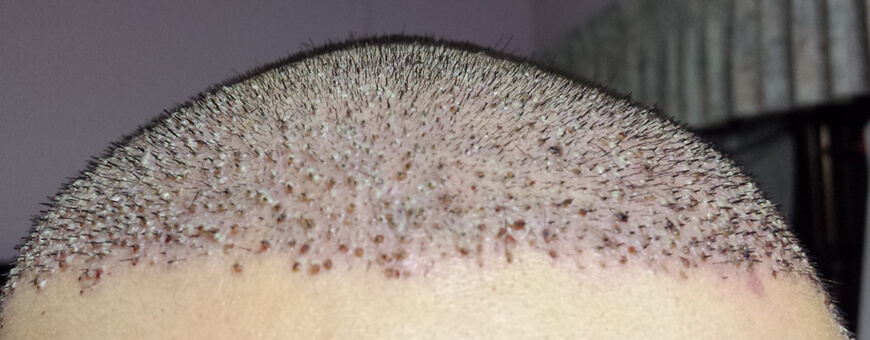
To remove scabs and crust after a hair transplant:
1️⃣ Wash your hair and scalp with a soft and warm stream of water.
2️⃣ Apply mild shampoo, preferably a shampoo provided/suggested by your hair transplant surgeon.
3️⃣ Gently massage your scalp with shampoo and warm water using your fingertips, and the scabs should soften/dissolve and fall out on their own.
3- Bleeding Around Donor and Recipient Sites
Again, the incisions made during the surgery cause trauma on the scalp, so blood or edema flowing through is completely normal.
But, some patients also experience regular and excessive bleeding during the first week after their surgery.
Bleeding following a hair transplant surgery depends on the following:
▶️ The patient’s blood flow and blood thinness,
▶️ blood thinners or medications that cause blood thinning used by the patient,
▶️ and the pre-existing conditions regarding blood coagulation.
The hair transplant surgeon will ask about these variables prior to surgery and should inform you if there’s a higher chance of bleeding in your case.
⚠️ There’s no need to be alarmed unless the bleeding gets more severe or continues through the second week following the surgery.
Otherwise, you should consult your physician if the bleeding is unexpected and excessive.
4- Itching Around the Recipient Site
Your scalp will certainly start itching because of the scabs and crust that form around the surgery site.
Again, itching should go away once the recipient and donor areas are healed, which should take around a week.
👉 Similarly, you also should NOT scratch your scalp or pick scabs under any circumstance since it’ll only make the situation worse, harm the healing process, and risk infections and poor results.
5- Swelling (On Forehead, Eyelids, Face)
Another common side effect that brings a bit more discomfort into a hair transplant patient’s life is swelling around the forehead, eyelids, and face in general.
Swelling begins 2-3 days following the surgery, as a ton of edema is produced in response to the micro-trauma caused by the incisions made during the surgery. Swelling lasts for 3 days on average.
Now, swelling differs drastically between patients; it can be mild with minimal pain or severe with throbbing pain around the face. Some patients might even have a hard time opening their eyelids to see.
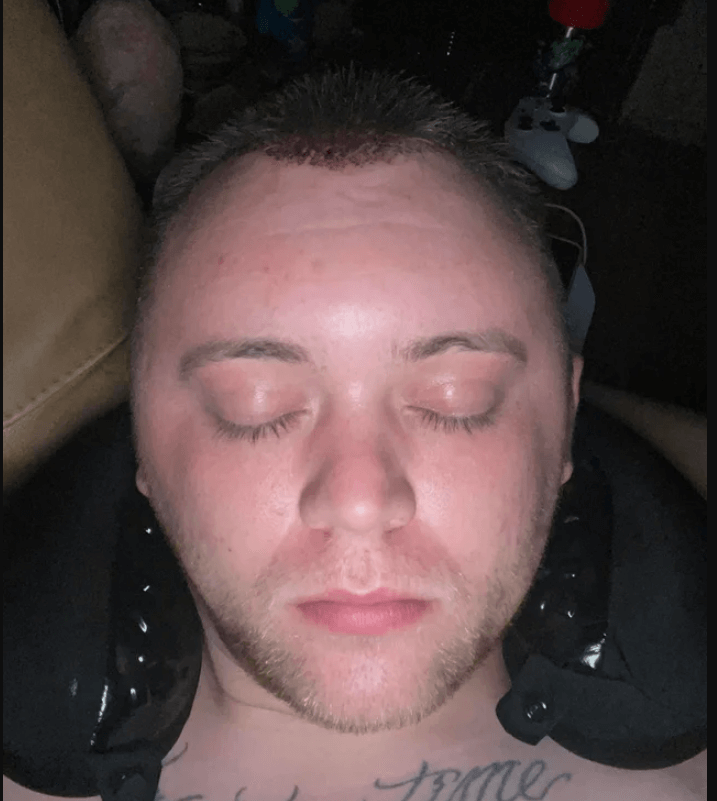
There are various precautions to minimize swelling, as well as ways to treat it once it happens.
To reduce and treat swelling after a hair transplant:
*️⃣ Choose the DHI method for your hair transplant, which causes much less swelling than other hair transplant methods.
*️⃣ Make sure you always sleep in a position where you’re lying on your back with your head elevated around 45 degrees to ensure proper blood flow, which should significantly reduce swelling.
*️⃣ Once the swelling starts, you can apply cold compresses every 3 hours as well as bands/bandages starting with your forehead.
*️⃣ Also, intake of certain steroids through oral medications or direct injections can help you battle swelling by preventing the production of enzymes that cause inflammation. You should consult and work with your dermatologist for this method.
6- Scalp Pain and Discomfort
The first few days after the surgery, during the initial healing, you will go through intense pain, tightness, and overall discomfort around your scalp.
But painkillers are prescribed mainly for this period, so you will not experience much during these days.
Once you’re off the painkillers, it is natural for you to still feel some pain and discomfort, but it is very mild for the majority.
Most patients commonly experience pain in the donor area rather than the recipient area, and this pain is much higher in FUT, where grafts are harvested from a strip of tissue cut from the scalp.
💊 If the pain persists, you can continue with over-the-counter painkillers after consulting your physician.
7- Loss of Sensation and Numbness
In most cases, right after the initial healing period, a loss of sensation and numbness will replace pain and discomfort in the recipient and/or donor areas.
This is another temporary side effect, and it shouldn’t take more than 2-3 weeks for most of the sensation to return to the scalp.
💡 However, complete recovery takes much longer, and it is normal for patients to experience slight numbness around the scalp for 6-8 months after the surgery.
8- Shock Loss
Your scalp goes through a severe amount of stress during and following a hair transplant surgery. I’m not even talking about the hair follicles that were extracted from the back of your scalp and transplanted into the recipient area.
It’s entirely natural for your body to react to this stress, and in most cases, this reaction comes in the form of a sudden hair loss in the recipient area, called “shock loss,” a few weeks following the surgery.
☘️ But, for almost all cases, shock loss isn’t permanent, and new hair grows in the place of the fallen grafts.
In a few months, commonly around 6-8 months after the surgery, your new hair that fell out during shock loss too should grow and mature, contributing to your natural look.
9- Reddish Skin
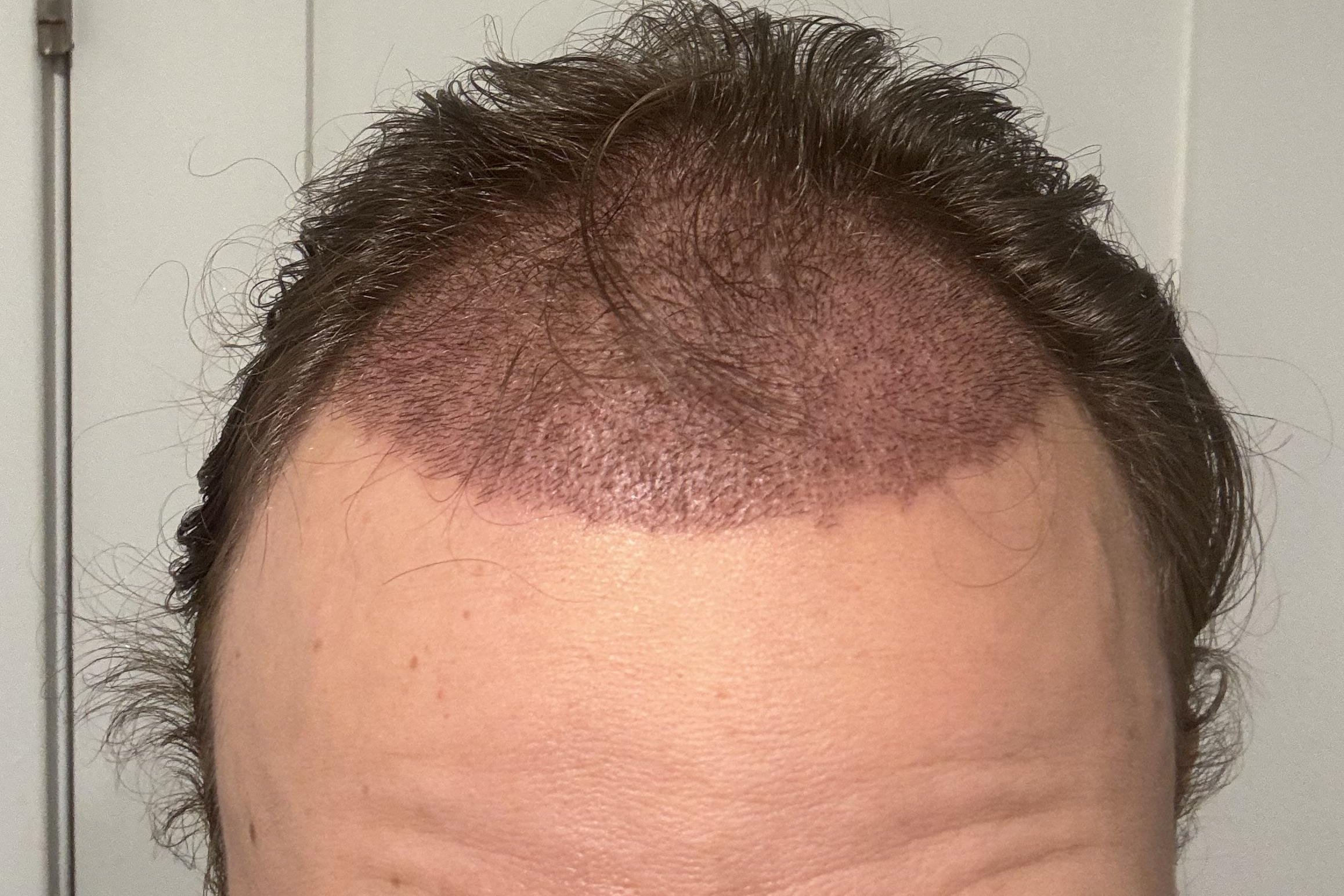
Redness on your scalp following the surgery is also natural to some degree and is part of the recovery process.
Since your scalp just went through a lot of stress and micro-trauma, a significant amount of blood is being pumped into it, hence the red color.
However, you should be cautious about reading your body’s reactions.
The redness should be the most significant during the first week after your surgery and should start to fade away as time passes (which could take months for some patients).
⚠️ If you see more discoloration on your scalp, or it doesn’t begin to go back to normal, it can be an indication of an infection, and you should immediately consult your physician.
10- Scars Around Surgical Sites
Numerous clinics and physicians promote their services as “scar-free,” which is totally not true and impossible.
In 2024, no hair transplant surgery is entirely “scarless.”
Even though the newest hair transplant techniques drastically reduce scars, there will still be some left.
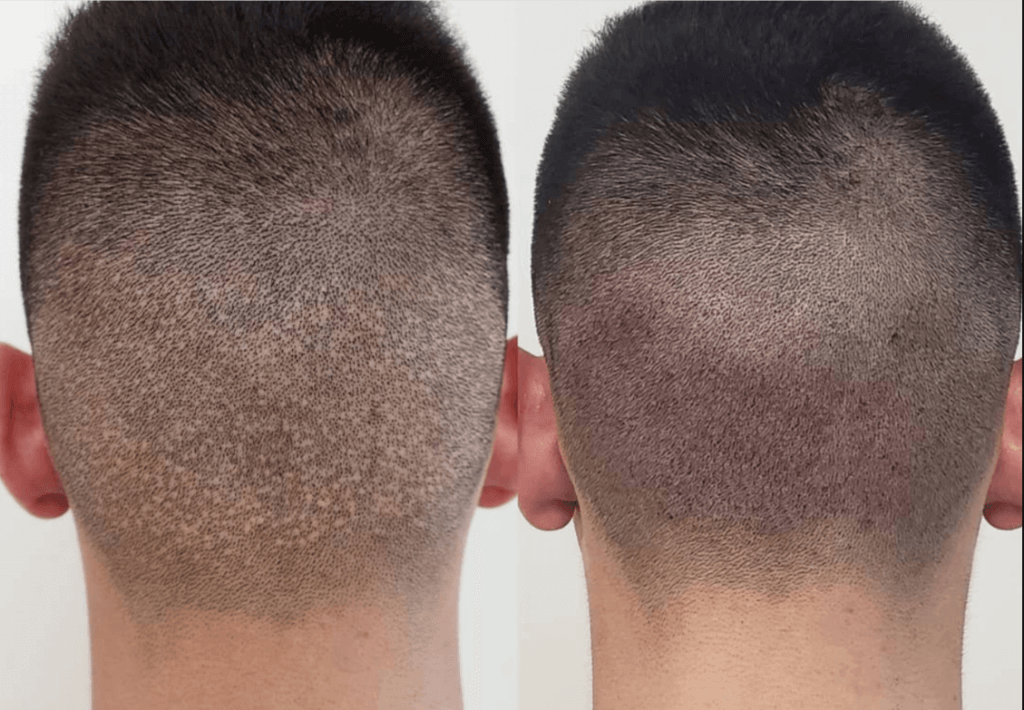
In FUE surgeries, in the donor area, tiny scars will remain on parts where the harvested follicles used to be. For most patients, these scars aren’t noticeable unless they are closely examined.
It’s a whole another story in FUT surgeries:
11- Linear Scar Around the Donor Site
The biggest downside of FUT surgeries compared to its better alternative, FUE, is certainly the linear scar caused by strip transplants.
In a FUT surgery, the surgeon cuts a strip of tissue from the donor site, which holds the needed amount of hair grafts for the hair transplant. Then, hair follicles are extracted from this separated tissue.
As the harvesting is done in a much more concentrated area and the skin tissue is extracted with the hair follicles, this extraction site remains a scar.
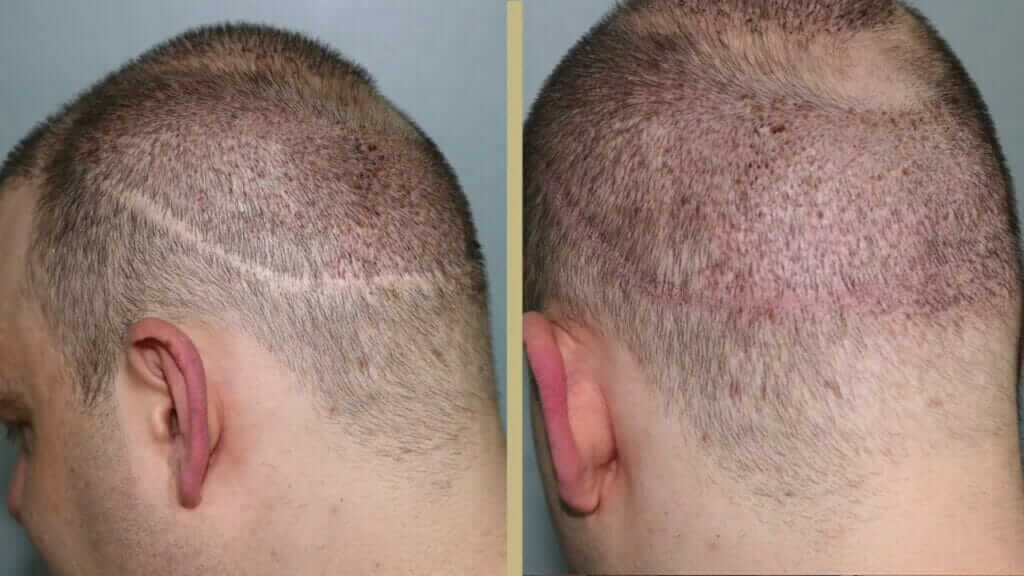
This linear scar is easily noticeable, and most FUT patients are required to grow their hair to a certain degree to hide this scar.
Safest Results Require the Expert Touch 🩺
It’s crucial that your hair transplant surgeon has the necessary amount of knowledge about each of these complications.
Unfortunately, based on my experience as a dermatologist and what I see/hear in the field, I can’t say most surgeons do,
That’s why, with a vision that puts health and safety as the number one priority, we’ve started UnitedCare.
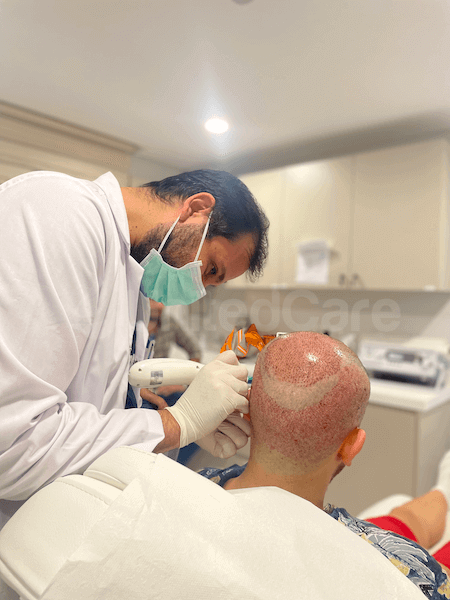
👉 At UnitedCare, we accept only 1 patient a day regardless of the chosen method.
The budget-friendly process begins with a free one-on-one consultation with our expert dermatosurgeons to determine your suitability.
💊 Our holistic approach provides advanced technologies and bio-enhancements to ensure you do not need another surgery.
We use intracellular solutions (a.k.a bio-enhancements), helping cells stay alive for days outside the body. These solutions increase graft survival rates significantly. 💉
Most importantly, our care assistant/patient manager is in contact with our patients even before and after the surgery, ensuring that your transplant becomes permanent. 🍀
Affordable costs, a holistic approach, and experienced on-site dermatologists are here to provide you with the right solution.
Ready to begin the journey? Click here to start the first step with a free consultation:
Choosing the right clinic is the key to avoiding any side effects.
UnitedCare Clinic’s expert dermatosurgeons can ensure your safe future now:
Frequently Asked Questions (FAQs)
Are there any long-term side effects of hair transplant?
Hair transplant side effects that last the longest are scars (permanent), loss of sensation (up to 6 months), and shock loss (8 months until complete regrowth).
Are hair transplants safe?
According to many studies and reports, hair transplant surgeries are completely safe end-to-end, and the crushing majority of surgeries end in partial to complete success.
Does a hair transplant affect the brain?
It is impossible for a hair transplant to have any effect on the brain since there is still a significant layer of tissue, as well as the human skull, between the operation site and the brain tissue. However, if left untreated and progressed for a very long time, an infection following a hair transplant can spread into deeper tissues and scalp and result in life-threatening conditions.
Can a hair transplant go wrong?
Yes, of course. Like every surgical method, hair transplant surgeries have a chance to go wrong. However, the rate for failure scenarios is low and, most of the time, directly connected to the skills and experience of the chosen clinic.
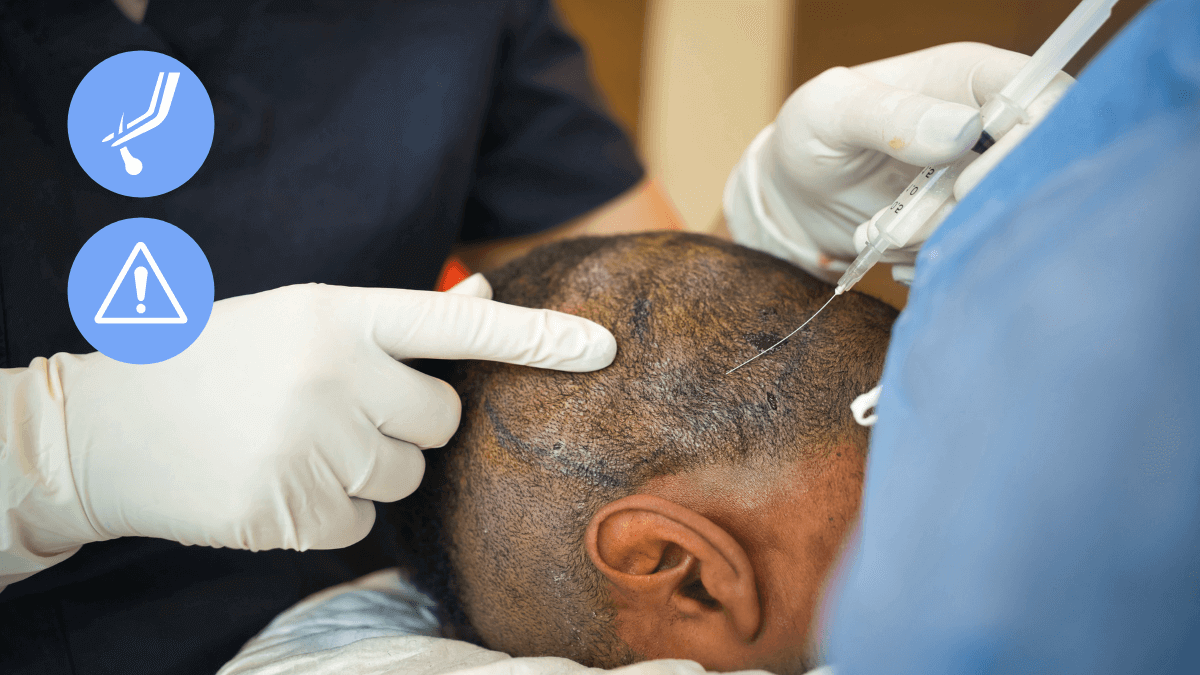

It seems like the clinic is professional and equipped with the skilled manpower. Where are ypou and what is your price per person?
Thanks.
Hello Gari,
Thank you for your kind words. The clinic is located in Istanbul and you can find our transparent pricing here.
Best.